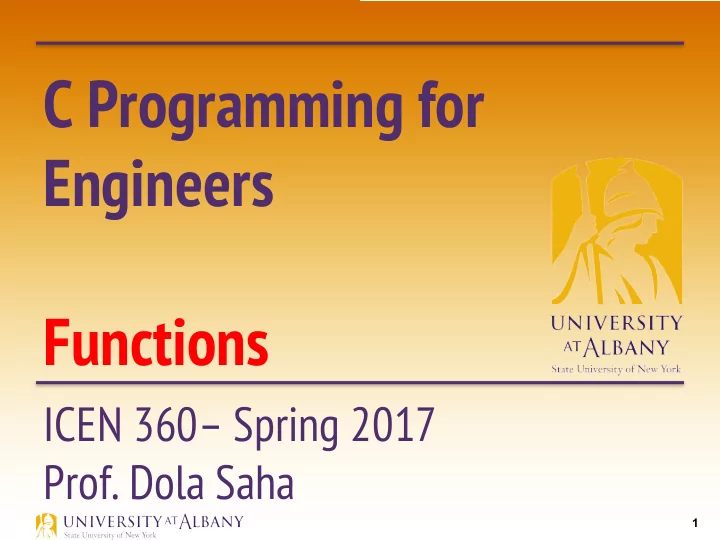

C Programming for Engineers Functions ICEN 360– Spring 2017 Prof. Dola Saha 1
Introduction Ø Real world problems are larger, more complex Ø Top down approach Ø Modularize – divide and control Ø Easier to track smaller problems / modules Ø Repeated set of statements 2
Example: Area and circumference of a circle 3
Computing Rim Area of a Flat Washer 4
C Code (1) 5
C Code (2) 6
Functions Ø Functions allow us to § modularize a program § reuse the code Ø Two types: § Programmer/user write, called programmer-defined functions § prepackaged functions available in the C standard library. Ø Input Variables Ø Output value, which is returned Ø Function body 7
Function Ø The statements defining the function are written only once, and the statements are hidden from other functions. Ø Functions are invoked by a function call, which specifies the function name and provides information (as arguments) that the called function needs to perform its designated task. 8
Modularizing Program Ø Analogy : Hierarchical management Ø A boss (the calling function or caller) asks a worker (the called function) to perform a task and report back when the task is done 9
Function Ø All variables defined in function definitions are local variables—they can be accessed only in the function in which they’re defined. Ø Most functions have a list of parameters that provide the means for communicating information between functions. Ø A function’s parameters are also local variables of that function. Ø The format of a function definition is return-value-type function-name(parameter-list) { definitions statements } 10
Example of User-defined Function 11
Function Definition Function square is invoked or called in main within the printf Ø statement printf( "%d ", square(x)); // function call Function square receives a copy of the value of x in the parameter y. Ø Then square calculates y * y. Ø The result is passed back returned to function printf in main where Ø square was invoked, and printf displays the result. This process is repeated 10 times using the for statement. Ø 12
Function Definition… cont. The definition of function square shows that square expects an Ø integer parameter y . The keyword int preceding the function name indicates that Ø square returns an integer result. The return statement in square passes the value of the Ø expression y * y (that is, the result of the calculation) back to the calling function. Ø int square(int y); // function prototype § The int in parentheses informs the compiler that square expects to receive an integer value from the caller. § The int to the left of the function name square informs the compiler that square returns an integer result to the caller. 13
Function Definition… cont. The compiler refers to the function prototype to check that any calls to Ø square contain § the correct return type § the correct number of arguments § the correct argument types § the arguments are in the correct order The function-name is any valid identifier . Ø The return-value-type is the data type of the result returned to the Ø caller. The return-value-type void indicates that a function does not return a Ø value. Together, the return-value-type, function-name and parameter-list are Ø sometimes referred to as the function header. 14
Function Definition… cont. Ø The parameter-list is a comma-separated list that specifies the parameters received by the function when it’s called. Ø If a function does not receive any values, parameter-list is void. Ø A type must be listed explicitly for each parameter. Ø The definitions and statements within braces form the function body, which is also referred to as a block. Ø Variables can be declared in any block, and blocks can be nested. 15
Return Control Ø Returns control to calling function after function execution § the function does not return a result, control returns immediately after the execution of function body § Returns after executing the statement return; § Returns the value of the expression to the caller by the statement - return expression; 16
main() ’s Return Type main has an int return type. Ø Ø The return value of main is used to indicate whether the program executed correctly. Ø In earlier versions of C, we had to explicitly place return 0; Ø at the end of main — 0 indicates that a program ran successfully. Ø main implicitly returns 0 if we omit the return statement. Ø We can explicitly return non-zero values from main to indicate that a problem occurred during your program’s execution. 17
Function Example: maximum() 18
Function Example: maximum() 19
Classwork Assignment Ø Compute rim area of a flat washer using function to calculate the area. 20
Math Library Functions Ø Performs common mathematical calculations. 21
More Math Library Functions Ø #include <math.h> 22
Self Review Assignment Ø Modify the program to compute the rim area of a flat washer using two functions § To calculate the area § To compute the square 23
Recommend
More recommend